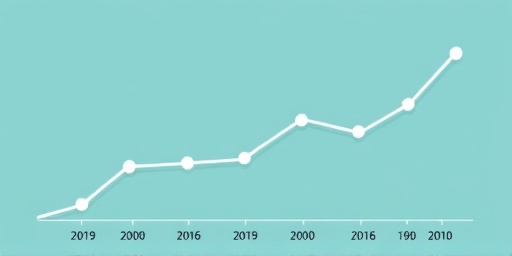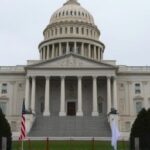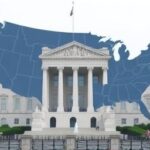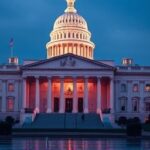Economists are sounding the alarm as Inflation is forecasted to stay elevated well into early 2026, complicating the Federal Reserve’s efforts to navigate a cooling economy. With recent data showing persistent price pressures, experts warn that upcoming quarters could see Inflation rates hovering above the central bank’s 2% target, driven by supply chain disruptions and wage growth outpacing productivity. This outlook comes at a precarious time, as a prolonged government shutdown has stalled the release of critical economic indicators, leaving policymakers and investors in the dark about the true state of the job market.
Economists Forecast Stubborn Inflation Trajectory Through 2026
In a series of reports released this week, leading economists from institutions like the Brookings Institution and Goldman Sachs have revised their projections upward for inflation. According to a Goldman Sachs analysis, core personal consumption expenditures (PCE) inflation—the Federal Reserve’s preferred gauge—is expected to average 3.2% through the end of 2025, only dipping below 3% in the first quarter of 2026. This persistence in inflation stems from a combination of factors, including lingering effects of global energy price volatility and domestic supply bottlenecks exacerbated by labor shortages.
“We’re seeing inflation that’s more entrenched than anticipated,” said Dr. Elena Ramirez, chief economist at the Peterson Institute for International Economics. “The usual cooling mechanisms, like moderating demand, aren’t kicking in as quickly as hoped, partly because wage inflation in service sectors remains robust.” Ramirez’s comments echo a broader consensus among forecasters, with the median projection from the Survey of Professional Forecasters indicating headline CPI inflation at 3.5% for the next two quarters.
Historical context underscores the gravity of this forecast. The last time inflation remained above 3% for an extended period was during the early 1980s, when the Federal Reserve under Paul Volcker hiked interest rates aggressively to tame double-digit price surges. Today, while rates aren’t as extreme, the current environment—with the benchmark federal funds rate at 5.25% to 5.50%—signals the Fed’s commitment to combating inflation, even at the risk of tipping the economy into recession.
Delving deeper into the drivers, economists point to sector-specific pressures. Housing costs, which account for about a third of the CPI basket, continue to climb, with median home prices up 5.4% year-over-year according to the National Association of Realtors. Meanwhile, food inflation, though down from pandemic highs, still lingers at 2.8%, influenced by adverse weather impacting agricultural yields in key producing regions.
Government Shutdown Delays Vital Economic Indicators Release
The ongoing government shutdown, now in its third week, has thrown a wrench into the dissemination of essential economic indicators, amplifying uncertainty around inflation and the job market. Federal agencies responsible for data collection, including the Bureau of Labor Statistics (BLS) and the Bureau of Economic Analysis (BEA), have furloughed thousands of employees, halting the publication of monthly jobs reports, GDP figures, and inflation metrics that markets rely on for informed decision-making.
This data vacuum is particularly acute for inflation tracking. The latest Consumer Price Index (CPI) report, due last Friday, remains unpublished, leaving analysts to rely on private sector proxies like the Cleveland Fed’s nowcast model, which estimates August CPI at 3.1%—a slight uptick from July’s 3.0%. Without official numbers, the Federal Reserve’s September meeting could proceed with incomplete information, potentially leading to a more cautious stance on rate cuts.
“The shutdown isn’t just inconvenient; it’s distorting our understanding of economic health,” noted Mark Zandi, chief economist at Moody’s Analytics. “Investors are pricing in higher volatility because they’re flying blind on key metrics like unemployment claims and nonfarm payrolls.” Zandi highlighted that during the 2018-2019 shutdown, similar delays led to a 1.2% swing in stock market indices within days of data releases, illustrating the ripple effects of such disruptions.
Broader implications of the government shutdown extend to fiscal policy. With Congress deadlocked on budget negotiations, spending bills remain stalled, which could inadvertently fuel inflation if emergency measures lead to unchecked deficit spending. Economists estimate that the shutdown alone could shave 0.1% off GDP growth in the current quarter, further pressuring the job market by delaying infrastructure projects and federal contracts that support employment.
Job Market Stability Under Scrutiny Without Fresh Data
As inflation dominates headlines, concerns are mounting over the job market’s resilience in the face of rising interest rates and data scarcity caused by the government shutdown. Pre-shutdown figures showed the unemployment rate holding steady at 3.8% in July, with 187,000 jobs added—below expectations but still indicative of a labor market that has cooled without collapsing. However, without August’s nonfarm payrolls report, economists are turning to alternative indicators like ADP’s private payrolls survey, which reported a modest 177,000 gain last month.
The interplay between inflation and the job market is a classic Phillips Curve dynamic, where tighter labor conditions can stoke wage pressures and, in turn, price increases. Recent data from the BLS’s Job Openings and Labor Turnover Survey (JOLTS) revealed 8.8 million job vacancies in June, a slight decline but still elevated compared to pre-pandemic levels. This mismatch suggests that while hiring has slowed, employers are struggling to fill roles, potentially sustaining inflationary wage growth at around 4.1% annually.
“The job market is at a tipping point,” warned Sarah Johnson, labor economist at the Economic Policy Institute. “If inflation forces the Fed to keep rates high longer, we could see layoffs accelerate in interest-sensitive sectors like construction and manufacturing.” Johnson’s forecast aligns with models from the Federal Reserve Bank of Atlanta, which predict a rise in unemployment to 4.2% by mid-2025 if inflation doesn’t abate.
Regional disparities add another layer of complexity. In tech-heavy states like California, job losses in Silicon Valley have offset gains elsewhere, with the state’s unemployment rate ticking up to 4.1%. Conversely, energy-producing regions in Texas report robust hiring, buoyed by oil prices above $80 per barrel. These variations highlight the uneven recovery, making national job market assessments even more challenging amid the shutdown’s data blackout.
To illustrate the stakes, consider small businesses: A National Federation of Independent Business survey found that 45% of owners cited labor costs as their top concern, up from 32% a year ago. Without timely economic indicators, these businesses face heightened risks in planning expansions or price adjustments, potentially exacerbating inflation through hoarding or premature cuts.
Federal Reserve Grapples with Inflation and Shutdown Challenges
The Federal Reserve finds itself in a bind as it weighs persistent inflation against the need to support job market stability, all while grappling with the fallout from the government shutdown. Chair Jerome Powell, in recent testimonies before Congress, emphasized a data-dependent approach, but the lack of official economic indicators has forced the central bank to lean on international benchmarks and high-frequency data like credit card spending trends.
At its July meeting, the Fed held rates steady, signaling that further hikes are off the table but cuts remain distant until inflation shows clearer signs of moderation. Projections from the Summary of Economic Projections (SEP) now anticipate only two rate reductions in 2025, down from three earlier in the year, reflecting the stubborn nature of price pressures. “We are well aware of the risks to both sides of our dual mandate,” Powell stated during a press conference. “Inflation remains our primary focus, but we won’t ignore softening labor conditions.”
Internally, Fed officials are divided. Hawks like Governors Christopher Waller advocate for vigilance on inflation, citing risks from geopolitical tensions in the Middle East that could spike oil prices. Doves, including regional presidents from softer economies, push for preemptive easing to safeguard jobs. This tension is compounded by the shutdown, which has delayed Treasury auctions and fiscal data, indirectly affecting the Fed’s balance sheet management.
Looking at quantitative easing’s legacy, the Fed’s $9 trillion balance sheet continues to unwind slowly, with quantitative tightening reducing holdings by $95 billion monthly. Yet, with inflation elevated, some analysts speculate a pivot back to accommodative tools if the job market weakens sharply. Market futures, via tools like the CME FedWatch, now price in a 65% chance of a rate cut by March 2025, but this could shift dramatically once shutdown-delayed data resumes.
Long-Term Implications for Economy and Policy Outlook
As the dust settles from this inflationary episode and the government shutdown’s disruptions, the road ahead points to a more volatile economic landscape through early 2026. Consumers may face sustained higher costs for essentials, with household budgets strained by cumulative inflation exceeding 20% since 2021. Businesses, particularly in retail and hospitality, will need to navigate pricing strategies carefully to avoid alienating customers while covering rising input costs.
Policy responses will be pivotal. The Federal Reserve may extend its higher-for-longer rate posture, potentially until mid-2026, to anchor inflation expectations. Meanwhile, resolving the government shutdown could unlock pent-up data flows, enabling more precise monetary adjustments. Congress might also prioritize bipartisan infrastructure spending to bolster the job market, targeting sectors like green energy where 500,000 new jobs could emerge by 2027, per Department of Labor estimates.
For investors, diversification remains key: Bonds yielding 4.5% on 10-year Treasuries offer a hedge against equity dips, while inflation-protected securities like TIPS could gain traction. Globally, the U.S. outlook influences partners; the European Central Bank has already cited American inflation as a reason for pausing its own rate cuts.
Ultimately, achieving the Fed’s 2% inflation goal will require concerted efforts across fiscal and monetary fronts. If the job market holds firm despite data lags, a soft landing remains possible—though economists peg its probability at just 40%. Stakeholders from Wall Street to Main Street must prepare for a prolonged period of elevated inflation, with the next few quarters serving as a litmus test for economic resilience.









